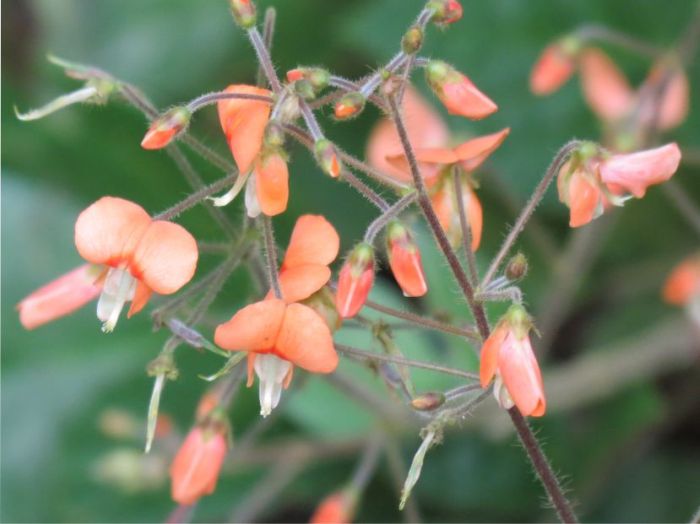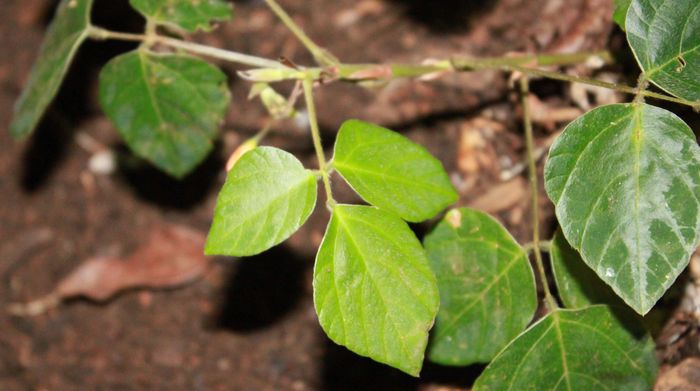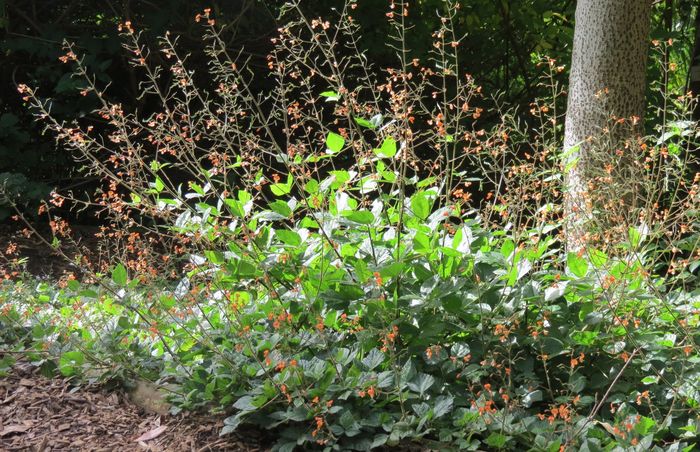Hylodesmum repandum
Hylodesmum repandum (Vahl) H.Ohashi & R.R.Mill (= Desmodium repandum (Vahl) DC.)
Family: Fabaceae
Common names: orange tick-trefoil, orange tick-clover, hitchhikers, beggar lice (Eng.)
Introduction
An attractive, shrubby, scrambling, perennial leguminous plant, with small, yet charming orange-red flowers in summer.

Description
Description
Hylodesmum repandum is a perennial herb or slender shrub with a woody base, climbing, scrambling, or forming dense undergrowth, 0.5–1.0 m tall. The stem is brown to reddish, from simple to greatly branched, terete to angular, hairy when juvenile, usually moderately to sparsely spreading pilose (covered with soft, slender hairs), smooth at the adult stage.

The leaves are dark green, trifoliolate (have 3 leaflets), with stipules 10–26 mm long, oblong-lanceolate to attenuate, about 2–6 mm wide, hairy on the upper surface and paler on the lower surface. The petiole is linear, covered with very fine hairs and usually long and flat; 8–110 mm long with a 5–20 mm long rachis. The leaflets are diamond-like in outline, with a sharply pointed apex and cuneate (wedge-shaped) leaf base; margin entire to repand (wavy); the upper surface is moderately long-strigose (covered with stiff hairs), whereas the lower surface, especially the veins, are more abundantly covered with small hairs; the margins usually ciliate (with a fringe of hairs). The terminal leaflets are 18–110 mm long and 15–85 mm wide.

Inflorescences elongate, 70–30 mm long, loose, terminal or axillary, racemose or racemose-paniculate, with a rachis that is uncinulate-puberulent (covered with minute hooked hairs) to moderately to densely soft spreading pilose. Bracts are 3.5–7.0 mm long and 2–3 mm wide, not long persistent, primary ovate-attenuate, puberulent (covered with minute hairs) with multicellular hairs and somewhat pilose on the outer surface, each subtending a fascicle (bundle) of 2–5 pedicels. The secondary bracts are 0.5–2 mm long and 0.3–0.5 mm wide, very small and ciliate (have a fringe of hairs on the margin), whereas the pedicels are 12–35 mm long, slender and lax, with pubescence similar to that of the rachis. Flowers are conspicuous, ranging from bright orange to brick-red. The calyx is 5.5 mm long, puberulent throughout and somewhat pilose on the teeth of both lobes. Corolla usually at least twice the length of the calyx, 8.0–12.5 mm long and 7.0–10.5 mm wide; standard almost orbicular, shortly clawed, with the wings being nearly oblong, long-auricled, shortly clawed, slightly shorter than standard, and the keel-petals are randomly elliptic, obtuse at apex, clawed, exceeding the other petals in length, being more than 14 mm long and 3.5 mm wide. Fruits are stipitate (on a small stalk), with the stipe being 2.0–4.5 mm long.

Pods are 13–45 mm long, flat, sticky, bluish green and dark chestnut-brown when ripe and separating into 1-seeded, crescent-shaped portions. It flowers from midsummer to midwinter (from December to June).
Conservation Status
Status
Hylodesmum repandum is not threatened; it is assessed as Least Concern (LC) on the Red List of South African plants.
Distribution and habitat
Distribution description
Hylodesmum repandum is widely distributed in the warm summer-rainfall regions of southern Africa, and is often one of the dominant components of shaded places in dry evergreen forest or rain-forest or at the forest margin, riverine Podocarpus forest and along roadsides, at elevation from 400–3 050 m. In South Africa, it occurs in the Limpopo, Mpumalanga, Gauteng, KwaZulu-Natal, Eastern Cape and Free State Provinces. It also occurs in Swaziland and in tropical East Africa, with a few populations in central Africa.

Derivation of name and historical aspects
History
The name Hylodesmum is derived from the Greek words hylos, meaning 'wood' or 'forest, and desmos, meaning a ‘bond’ or ‘chain’, which refers to the preferred forest habitat of plants in this group and the jointed pod which resembles the links of a chain. The specific epithet repandum, means ‘with slightly undulating or wavy margins’.
Ecology
Ecology
Hylodesmum repandum is adapted pretty well to partially to deeply shaded areas. The brightly coloured, conspicuous flowers attract different pollinating insects, such as honey-bees, butterflies, carpenter bees and flies, which pollinate them. The sticky pods are dispersed by animals (mainly cows) as they stick to the fur of passing animals, while they are feeding.
Uses
Use
As with many other legumes, Hylodesmum repandum has a symbiotic relationship with certain soil bacteria. These bacteria form nodules on the roots and fix atmospheric nitrogen, and are known as nitrogen-fixing bacteria. Some of the nitrogen is utilized by the growing plant, but some can also be used by other plants growing nearby, which makes it useful for enriching the soil. Furthermore, its roots are used in the treatment of stomach distress. It is also a good source of fodder for cows.
Growing Hylodesmum repandum
Grow
Growing Hylodesmum repandum is relatively easy and it can be propagated by cuttings and seed. This is a great feature plant for small gardens with forested or shaded areas, and an excellent garden filler. Space plants at least 1 m apart when planting, since it has a tendency to overgrow other plants. In late winter, prune overlapping branches almost to the ground, or cut back for shaping at least every 2–3 years and expect it to re-sprout in mid-summer to autumn. For increased growth, add an organic fertilizer.
Hylodesmum repandum is easily propagated from cuttings and responds very well from seeds. When propagating from cuttings prepare a well-drained soil, preferably consisting of 3 parts peat moss, 1 part compost and 1 part perlite, which should retain moisture. Collect cuttings in spring or summer mornings or evenings, when the plant is at its most vigorous. Choose and collect cuttings from a pest- and disease-free mother stock. Make cuttings from soft parts of the branches, as they root quicker than semi-hardwood growth, however, both root effectively. Make cuttings of ± 50 mm long, and make the cut just beneath a node. Use a rooting hormone (Auxin-containing – whether powder or liquid) before inserting the cutting in the rooting medium, keep them damp and shaded and rooting should take place between 2–3 weeks. Sow seeds in well-drained soil preferably 1 part sifted bark, 1 part sand and 1 part compost, in spring. Collect the ripe seed pods and store them in a cool and dry area for 2 weeks, then remove the outermost covering layer, to allow root emergence. Insert seeds above slightly compacted medium in spacing of about 5 to 6 cm, cover softly with a thin layer of sand, water with a soft spray, with a dilute disinfectant, using a watering can. Place in a warm, but shaded area. The seed germination should take place within 3 weeks. Once sufficient roots emerge, transplant in 4L bags or 9 cm pots and harden off in a cool, partially shaded area. Once root bound, it is ready for the garden.
Broad mites (not visible to the naked eye) have been spotted causing leaf deformation and other pests, such as aphids, white flies and mealy bugs, and they can be controlled by applying a horticultural oil with other alternatives, to prevent resistance.
References
- Fabian, A. & Germishuizen, G. 1997. Wild flowers of northern South Africa. Fernwood Press, Vlaeberg.
- Foden, W. & Potter, L. 2005. Desmodium repandum (Vahl) DC. National Assessment: Red List of South African plants version 2017.1.
- Manning, J. 2009. Field guide to wild flowers of South Africa. Struik Nature, Cape Town.
- Ohashi, H. & Mill, R. 2000. Hylodesmum, a new name for Podocarpium (Leguminosae). Edinburgh Journal of Botany 57(2):171-188. doi:10.1017/S0960428600000123.
- Pooley, E. 1998. A field guide to wild flowers Kwazulu-Natal and the eastern region. Natal Flora Publications Trust, Durban.
- Verdcourt, B. 2000. Papilionoideae. Flora zambesiaca 3 (6).
Credits
Kamogelo Solomon Modimola & Mpendulo Gabayi
Kirstenbosch National Botanical Garden
September 2019, name updated November 2023
Acknowledgements: the author thanks Mr Mpendulo Gabayi and Siqamo Yeko for their continuous help and for providing motivation to complete this article.
Plant Attributes:
Plant Type: Ground Cover, Scrambler, Shrub
SA Distribution: Eastern Cape, Free State, Gauteng, KwaZulu-Natal, Limpopo, Mpumalanga
Soil type: Sandy, Loam
Flowering season: Late Summer, Autumn, Winter
PH:
Flower colour: Red, Orange
Aspect: Shade, Morning Sun (Semi Shade), Afternoon Sun (Semi Shade)
Gardening skill: Easy
Special Features:
Horticultural zones










Rate this article
Article well written and informative
Rate this plant
Is this an interesting plant?
Login to add your Comment
Back to topNot registered yet? Click here to register.